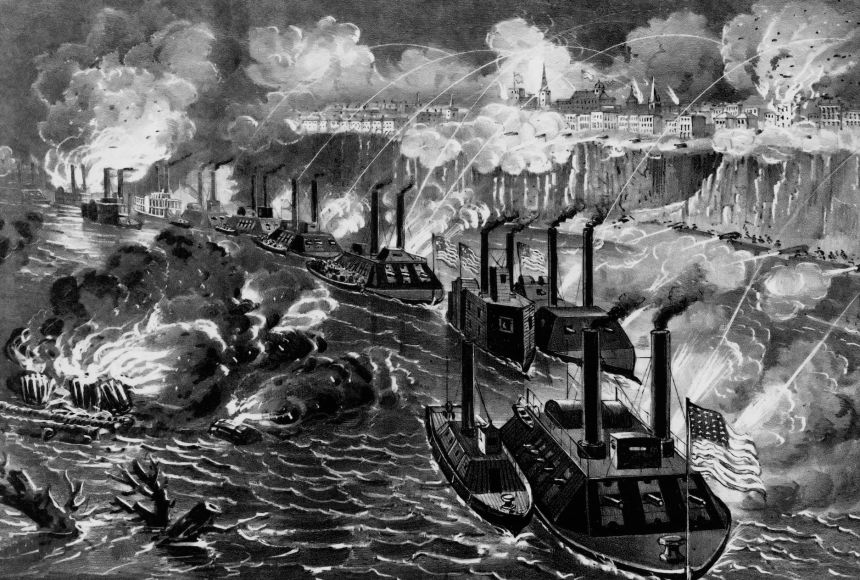The Civil War (1861–1865) was the bloodiest war in United States history. Hundred of thousands of soldiers died.
The Civil War was fought between the Union and the Confederacy. The Union was made up of the northern states. The Confederacy was made up of southern states. The Confederate states seceded, or left, the United States in 1861. They became the Confederate States of America. This led to the start of the Civil War.
There were more than 50 major battles during the war. Below are five of the most important.
First Bull Run (July 21, 1861)
The first Battle of Bull Run was the war's first major battle.
It began after Union forces marched out of Washington, D.C. The Union troops were commanded by General Irvin McDonnell. Their goal was to take control of Richmond, Virginia. Richmond was the capital of the Confederacy.
The marching Union troops were stopped by the Confederate Army. The two sides met in Manassas, Virginia. Confederate forces were commanded by General P.G.T. Beauregard.
A terrible battle quickly broke out. At first, it seemed as if the Union Army would win. However, the Confederates held their ground. More Confederate troops arrived after several hours of fighting. The now-stronger Confederate Army quickly defeated the Union forces. The Union Army left in defeat. They retreated to Washington, D.C.
About 4,800 soldiers from both sides died that day.
Shiloh (April 6–7, 1862)
In April 1862, the Union Army set out to take over an important Confederate train line. The line ran through Mississippi. To defend the line, Confederate forces gathered in Corinth, Mississippi. They were led by General Albert Sidney Johnston.
The Union sent two armies. The plan was to meet up and take Corinth together. One Union Army group was commanded by Ulysses S. Grant. The other was led by Don Carlos Buell.
Grant's army arrived first. They set up camp in Pittsburg Landing, Tennessee, near the Shiloh Meeting House. Johnston wanted to strike Grant's soldiers before Buell arrived. At dawn on the sixth of April, his forces attacked. Grant's Union men were taken by surprise. However, they fought back fiercely.
Buell's forces finally arrived overnight. The combined Union force attacked at dawn. Confederate forces were defeated. During the fighting, General Johnston was killed.
More than 23,000 soldiers from both sides died.
Antietam (September 17, 1862)
In 1862, Confederate General Robert E. Lee decided to attack the North. Unfortunately for Lee, his plans fell into Union hands. The Union quickly set out to stop him.
Lee's forces began marching on the North. The Union Army met them in Maryland, at Antietam Creek.
The long day of fighting ended in a draw. About 23,000 men were killed.
Gettysburg (July 1–3, 1863)
By the summer of 1863, Lee was ready to attack the North again.
Lee ordered his forces to march north. They were met by Union troops at Gettysburg, Pennsylvania. Union forces were commanded by General George Meade.
At first, the Confederates seemed to be winning. Yet the Union Army held on. They would not let the Confederates pass.
On the third of July, the Confederates made one last push. Lee ordered 15,000 Confederate troops to charge up Cemetery Ridge. This attack is known as Pickett's Charge. It broke through Union lines. In the end, though, the Confederates were pushed back.
Lee's forces retreated on the fourth of July.
The Union side lost 23,000 men. The Confederates lost about 28,000.
Vicksburg (May 22–July 4, 1863)
Vicksburg, Mississippi, sits halfway along the Mississippi River. If the Union could capture Vicksburg, it would control the whole river. However, the city was heavily defended. A large Confederate force protected it. It was led by General John C. Pemberton.
In May, Union troops under General Ulysses S. Grant attacked Vicksburg. They quickly surrounded the city. Confederates soldiers were trapped inside Vicksburg. By mid-June, they had few supplies and were beginning to starve. General Pemberton surrendered on the fourth of July.
The battles of Gettysburg and Vicksburg marked the turning point of the Civil War. From then on, the Union had the upper hand. It was only a matter of time before the North would win the war.

